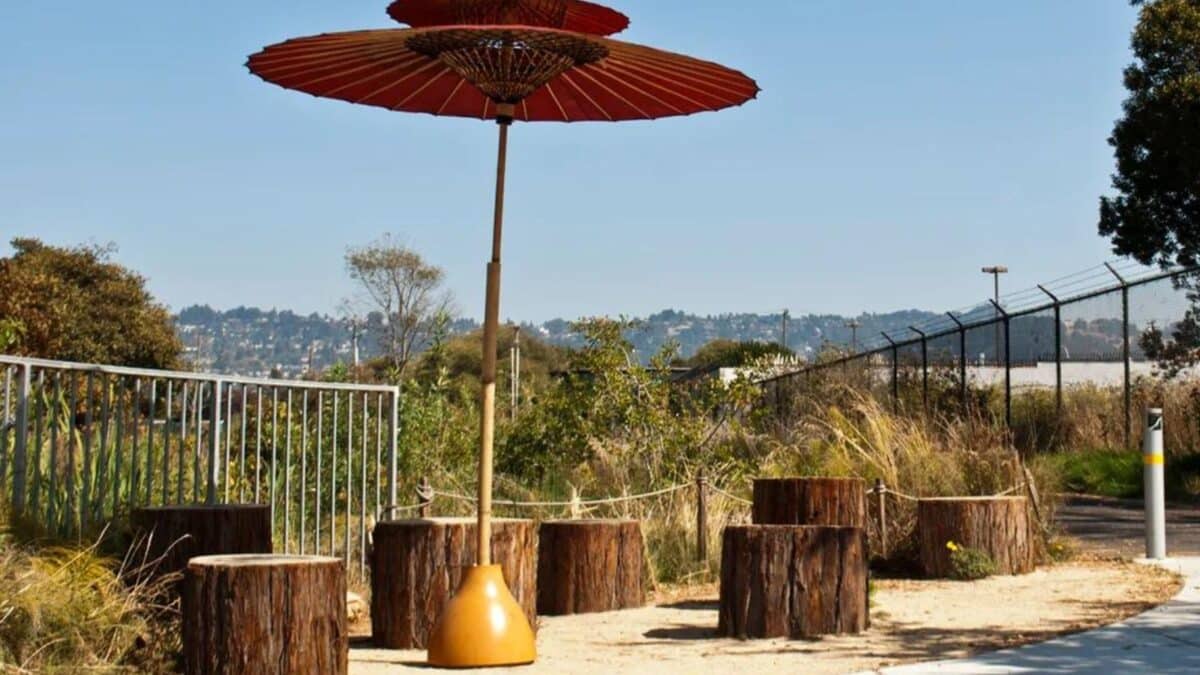Ah, summer—the season of sipping iced beverages, basking in the warm rays, and splashing in the cool, refreshing waters of the pool. But as any sun-worshipper knows, those glorious rays can quickly turn from blissful to brutal. Enter the cute poolside hack that’s about to make your summer lounging dreams more comfortable, courtesy of Instagram creator E. Stübing @herzenstimme.
This DIY maven has taken the humble umbrella stand and elevated it to new heights (literally) by transforming it into a mobile, multifunctional piece that doubles as a chic side table.
DIY Umbrella Stand IKEA Planter Hack
The star of the show? The IKEA PS FEJÖ self-watering plant pot. This unexpected gardening item serves as the base for the umbrella stand, providing a sturdy foundation while also offering built-in wheels for easy maneuverability. But that’s not all. By incorporating the IKEA SNUDDA turntable as a tabletop, Stübing added a super useful feature to an umbrella stand.
Now, you can effortlessly roll your umbrella stand to wherever the perfect patch of shade or sunshine beckons, all while enjoying a sleek surface to rest your iced tea or latest reading material.
The DIY umbrella stand is quick and easy. Here’s how she did it.
Materials:

- IKEA PS FEJÖ self-watering planter
- SNUDDA turntable
- Quick-drying concrete
- Water
- Pipe
- Hole Saw
- Hand Saw
How To DIY a Patio Umbrella Planter Stand
- Get an IKEA PS FEJÖ self-watering plant pot and remove the special insert.
- Center the pipe within the pot. It is not shown in the reel, but you can use a dab of construction adhesive to glue the pipe to prevent unwanted movement during the next step. At this point, you don’t need to cut the pipe down to the right length.
- Next, pour a bag of quick-drying concrete into the pot, following the manufacturer’s instructions for the ideal water-to-concrete ratio. Set aside.
- As the concrete sets, turn your attention to the IKEA SNUDDA turntable. Remove the rotating base and use a hole saw to cut an opening in the tabletop, ensuring the diameter is large enough to accommodate the pipe.
- Once the concrete has fully cured, it’s time to cut the pipe to the perfect height, allowing the SNUDDA table to sit flush atop the planter.
- For added protection from the sun, treat the SNUDDA turntable with wood oil before use. And store the table in a dry area, out of rain.
- Pop the tabletop into place, slide the base of your parasol into the pipe, and voilà! You’ve got yourself an umbrella stand on wheels that doubles as a nifty side table.
In her Instagram caption, Stübing says about the versatility of her creation, “The best thing is you can push anywhere in your garden where the umbrella is needed.”
Her clever DIY has garnered almost 55K likes, and scores of people have replicated it. Since she hacked this umbrella stand last summer, it has proven its durability and functionality, holding up well against the elements and countless lazy afternoons spent lounging on the patio.
Safety Considerations:
- To add stability and minimize the risk of the umbrella taking off with a strong gust of wind, consider drilling a hole through the pipe holder and inserting a bolt to secure the parasol pole to the stand.
- Keep in mind the simple rule is that the larger the parasol, the heavier the base needs to be. As the PS FEJÖ planter is not very large or wide (only 12 ½ inches in diameter), use a smaller umbrella with it.
- It is recommended not to open and use a parasol in strong winds.
- Always store the umbrella stand planter in a shaded area away from the rain and sun.
Concrete Umbrella Stand From Lamp Shade

The IKEA Melodi lampshade makes a perfect concrete mold for an umbrella stand. It’s cheap, attractive, reusable, and comes in two sizes.
Materials:
- IKEA MELODI Lamp Shade
- Plywood Base Board
- 2.5″ Galvanized Pipe
- Foam Strip
- Modeling Clay
- Silicone Caulk
- CHENG Outdoor Pro-Formula
- 100+ pounds Concrete Mix
DIY Umbrella Stand Base
The first step is to drill a 2″ hole in a plywood base. A PVC or galvanized pipe fits in the hole, and then, the lampshade slides over the pipe and onto the board.

A small wooden frame is built to hold the lampshade in place, and some modeling clay and silicone are used to seal the form at the bottom.

Filling the form with concrete is the easy part. Wait a few days for it to cure before taking the concrete out of the form. Then, cut the pipe down with a hack saw, polish the top of the concrete, drill a drainage hole, and install some furniture bumpers to protect the concrete and the floor.

The finished umbrella stand weighs about 100 pounds, making it stable enough to hold the biggest umbrellas.

Check out the Instructable in the link for the full step-by-step.
~ by CHENG Concrete, Berkeley, California, USA

